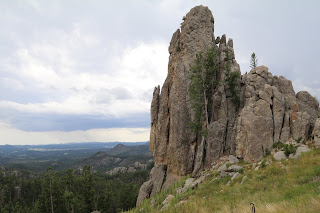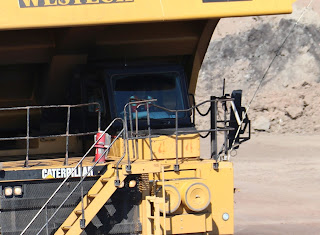We have had a lot going on since Yellowstone and are just now getting back to posting on the blog. As I write this we are in Mitchell, SD on our way to Green Bay, WI to visit Pam's brother. We have concluded our three month sightseeing itinerary and will make our way home after the visit to Green Bay. Since Yellowstone we have been to a Family Motor Coach Association (FMCA) rally in Gillette Wyoming and toured the Black Hills in South Dakota. The FMCA rally in Gillette was the catalyst for our trip. I am a voting member of the Governing Board of FMCA and expected to attend the FMCA summer rally. If we were going to spend the money to get to Gillette we thought it made sense to combine that travel with a western adventure.
We have been to larger FMCA rallies but this one had modest attendance with over 1600 coaches. On Monday, July 16, we rendezvoused at the Gillette Walmart with a couple, Roy and Debbie, from Sacramento California and drove into the rally together. That allowed us to be parked in the same area. Roy, Debbie, Pam, and I had signed up for the Durham Ranch and the Eagle Butte Mine tours. Pam and I had been on both tours when we were in Gillette five years ago but wanted to repeat them. This was Roy and Debbie's first FMCA rally and we acted as their mentors. The following photo taken from the roof of our motorhome shows about 1/3 of all the RV's in attendance. The Gillette Cam-Plex is a large complex ideal for these types of events.
FMCA at Gillette
The Durham Ranch is a 55,000 acre bison ranch owned and operated by the Flocchini family to provide bison meat to their Sierra Meat Company. It was interesting to hear the ranch foreman explain how the 1900 head herd of bison are managed and cared for. He explained how the herd is moved to different pastures frequently to give the grass an opportunity to replenish and went over how the bison are examined, tagged, vaccinated, and entered into a computer database. He also covered the criteria used to determine whether a bison remained in the breeding program or was selected to be shipped to the slaughter house. The following two links contain additional information for those interested.
https://durhambisonranch.com/
https://sierrameat.com/
Front gate at Durham Ranch
Eastern coal has a high sulfur content and when burned in coal fired power plants precipitates acid in the atmosphere. The coal from Wyoming has a much lower sulfur content and for that reason most of the coal used in the United States is mined in the Gillette area. The coal in this area is between 250 to 350 feet below the surface and the soil above the coal is referred to as overburden. The overburden is removed and stored and each mining company is required to reclaim the land once the mining operation is complete. The mines operate 24/7 - 365 days a year shipping most of the coal via railcars. Trains travel thru the silos and are loaded at a pace of approximately 0.6 MPH. It takes between 2 and 2.5 hours to load a train. The trains are weighed as they enter the mine and again as they leave. This determines the tonnage to bill each customer. Each train car holds approximately 120 tons of coal and there are 115 to 140 cars per train. The average loaded train contains between 15,000 to 20,000 tons of coal. After each loaded car passes out of the silo a chemical is sprayed onto the coal at the top of the car to prevent the coal from flying off as the train travels to its destination. This chemical is consumed when the coal is burned. Someone on the tour jokingly referred to this as "hairspray for coal"
The Eagle Butte mine has 4 silos 70 feet in diameter by 210 feet tall. Each silo holds 10,500 tons of coal. Haul trucks dump coal into a hopper where it is crushed to a 2 inch final product and moved to the silos by a conveyor. I made a youtube video thru the window of the tour bus of a haul truck dumping coal into the hopper. Go to the link below to view the video. The haul trucks are massive and have a carry capacity of 240 tons and an empty weight of 185 tons. Eagle Butte mine has 14 overburden trucks and 8 coal trucks. The Model 793 Caterpillar truck has a 1200 gallon fuel tank and a 16 cylinder engine that produces 2350 horsepower. The engine contains a staggering 155 gallons of oil. How would you like to do an oil change on that puppy. The cost of a truck is $3.8 million and a new tire cost $28,000 each.
Pan and I inside a retired shovel bucket
Roy and Debbie next to a haul truck tire
Haul truck headed to hopper with a load of coal - notice the ladder in font of the radiator used by the operator to climb up to the cab.
Close up of cab - look close and you can see the orange vest on the driver
Notice the two workers standing between the haul truck and the pickup truck
Water truck used to keep the dust to a minimum
Shovel filling haul truck
Train passing thru silo
Chemical being applied to surface of coal - hairspray for coal
Conveyor that carries coal from hopper to silos
YouTube video of haul truck dumping coal into hopper.
https://youtu.be/AAWmYxUcqsA


























































